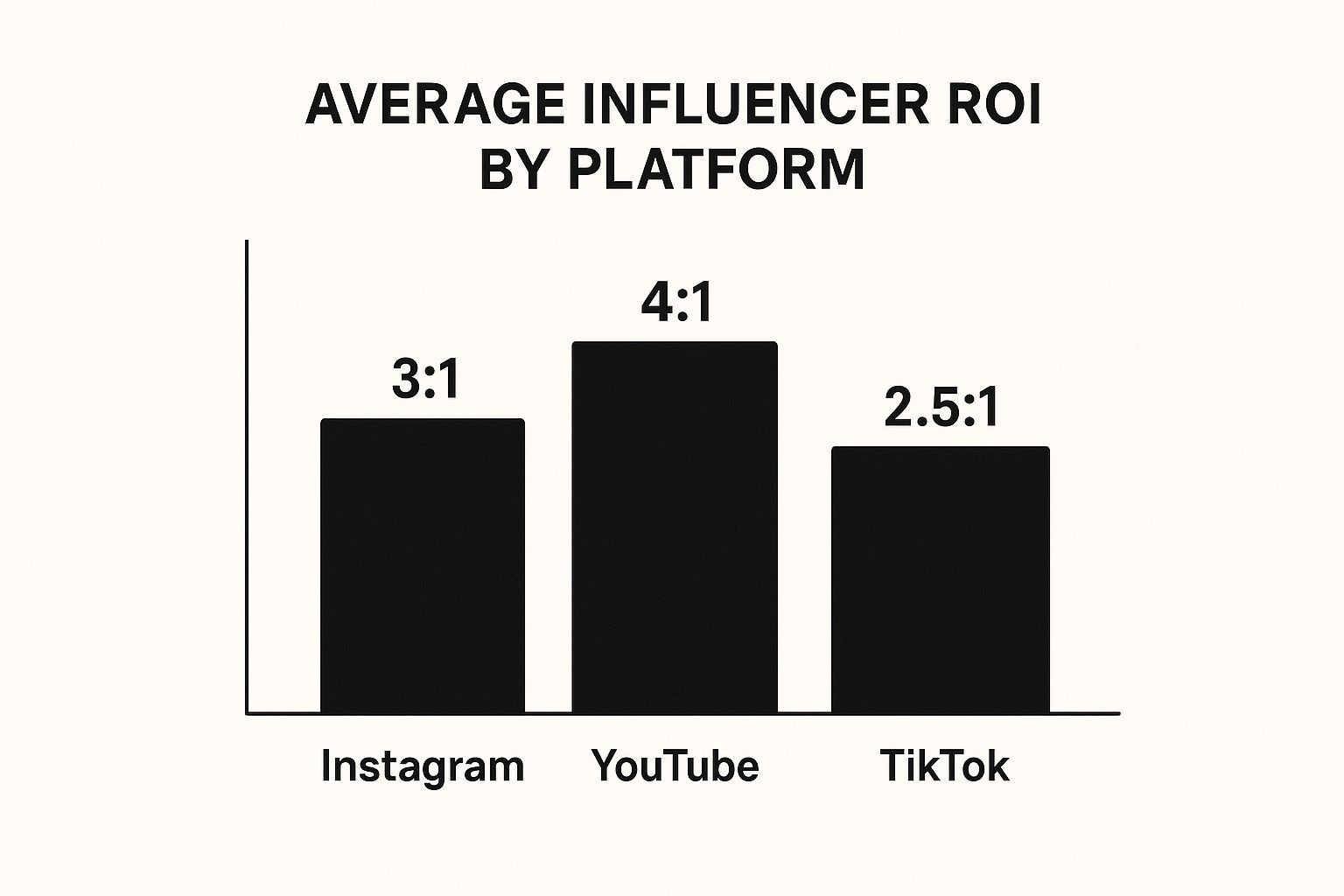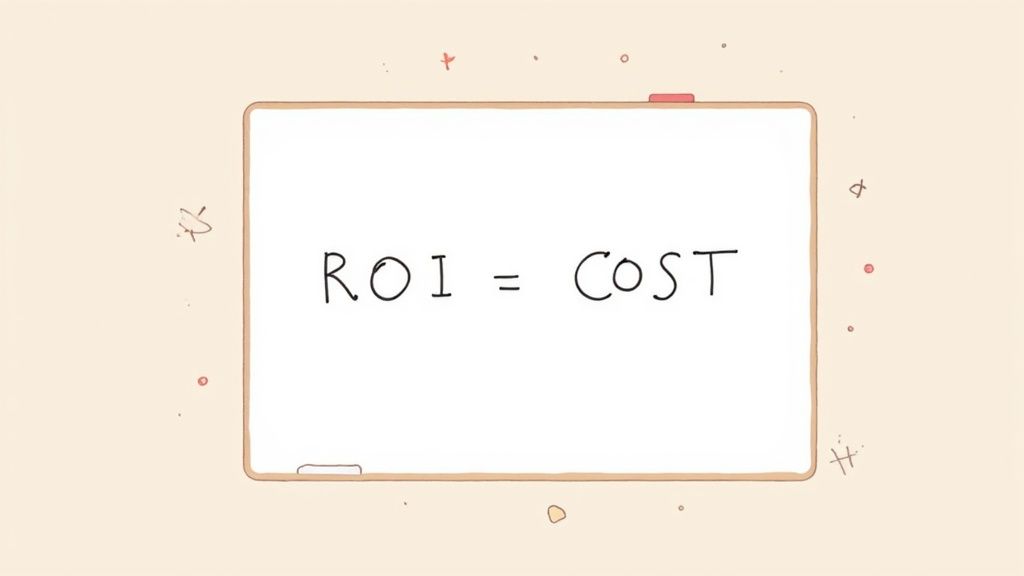
Boost Your Influencer Marketing ROI with Proven Strategies
Published
Understanding What Influencer Marketing ROI Really Means

Figuring out influencer marketing ROI (Return on Investment) involves more than just tallying likes or shares. It’s about recognizing the concrete business results that come from these partnerships. Many in marketing now look past simple vanity metrics to see the real effect on their financial performance, which requires a more detailed look than typical marketing measurements.
Moving Beyond Surface-Level Metrics
To truly understand influencer marketing ROI, one must consider the entire impact. While initial engagement numbers are straightforward to track, effective programs examine deeper results such as lead generation, sales conversions, and changes in how the brand is perceived. A significant statistic shows that businesses, on average, can earn approximately $4.21 for every dollar spent on influencer marketing through platforms like Instagram. This highlights the potential when campaigns are well-planned. Explore this topic further for more influencer marketing statistics.
This strong average return underscores why a clear grasp of influencer marketing ROI is so important. However, the returns can differ greatly based on the social media platform and the specifics of the campaign strategy. The infographic presented earlier provides a comparison of average influencer ROI across key platforms. This data indicates that while Instagram delivers good returns, YouTube often shows the highest average ROI for influencer work, with TikTok also demonstrating considerable potential.
To help illustrate these differences, the following table offers a comparison of ROI metrics across popular platforms.
Influencer Marketing ROI By Platform Comparison
A detailed breakdown of average ROI performance across different social media platforms and campaign types.
| Platform | Average ROI (per $1 spent) | Best Campaign Type | Typical Engagement Rate |
|---|---|---|---|
| $4.21 | Sponsored Posts, Stories, Reels | 1-3% | |
| YouTube | $5.00 - $6.50 | Dedicated Reviews, Video Integrations | 2-5% |
| TikTok | $4.50 - $5.75 | Viral Challenges, Branded Hashtags | 5-15% |
This table shows that while Instagram offers a solid documented return, platforms like YouTube and TikTok can yield even higher ROI, depending on campaign execution and audience alignment. Engagement rates also vary widely, with TikTok often leading in organic interaction.
Frameworks for Capturing Full Value
To properly measure influencer marketing ROI, businesses should use methods that consider both direct and indirect advantages. This involves tracking elements such as:
- Custom discount codes
- Affiliate marketing links
- Website traffic referrals
Additionally, keeping an eye on brand mentions, audience sentiment, and the expansion of your own social media profiles gives a fuller view of the wider effects.
Recognizing these factors helps distinguish successful influencer initiatives—those that fuel growth—from efforts that consume budgets without producing significant outcomes. By concentrating on thorough measurement and actual results, you can make more informed decisions about your influencer investments.
Measuring What Actually Drives Campaign Success

While direct revenue offers a straightforward look at influencer marketing ROI, it doesn't show the whole story of a campaign's effect. To truly gauge success, it's important to look past initial sales figures and understand the complete value that influencer partnerships contribute to a brand, influencing how people see it and their loyalty in the long run.
Deeper Insights Beyond Sales Figures
This wider perspective means assessing how collaborations support lasting brand health and connections with the audience. For instance, metrics such as engagement quality, which examines the substance of comments and shares rather than just their quantity, offer more meaningful information. Likewise, changes in brand sentiment, measured through social listening, show how your audience's feelings about your brand have shifted after a campaign.
Moreover, strong audience alignment between the influencer and your intended customers is essential. An influencer could achieve high engagement, but if that engagement doesn't come from your potential buyers, its effect on influencer marketing ROI will be constrained. These aspects are vital for developing enduring brand value and making sure your message connects appropriately.
Indeed, the engagement rate is a key measure for evaluating how well influencer marketing campaigns perform. While only about 30% of marketers focus on sales as the primary success marker, metrics like engagement, reach, and overall brand lift are more commonly used to judge campaign results, indicating a preference for wider effects. You can find more detailed statistics about influencer marketing on Shopify's blog. This highlights a distinct industry movement towards prioritizing interaction and awareness.
Building Robust Measurement Frameworks
To understand this wider impact, successful marketers create measurement frameworks. These are set up to monitor both immediate outcomes, such as click-through rates from particular links, and the growth of long-term brand value, like an increase in brand-related searches. This thorough method assists in evaluating the true effect of campaigns, going beyond basic conversion figures.
Establishing clear Key Performance Indicators (KPIs) is crucial for monitoring these diverse results efficiently. These KPIs should match your overall marketing goals, whether that's increasing brand awareness, generating leads, or fostering a community. For more details, you might find this article on Essential Influencer Marketing KPIs to Track useful.
Methods for tracking combine both qualitative and quantitative techniques. These could include:
- Analyzing comment sentiment to grasp how the audience perceives your brand.
- Using unique tracking links and customized promo codes for individual influencers to connect direct sales and leads to their efforts.
- Monitoring website referral traffic and examining social media mentions and your brand's share of voice.
This in-depth tracking does more than just support ongoing investment in influencer marketing; it also supplies the necessary data to improve and adjust future campaigns. By figuring out what genuinely makes a difference, brands can make more informed choices. This ensures their influencer marketing ROI mirrors real business expansion and deeper brand connection, setting the stage for more strategic and fruitful partnerships.
Smart Influencer Selection For Maximum Returns
Picking the right people to work with is crucial for getting a good influencer marketing ROI. Not every collaboration will be a home run; the best outcomes come from choosing influencers strategically, focusing on real connections and results you can measure, rather than just how many followers they have.
Balancing Follower Count, Engagement, and Alignment
When selecting an influencer, it's tempting to focus on their follower count, but that's only part of the picture. Authentic engagement and audience alignment are just as important if you want to see a strong influencer marketing ROI. An influencer might have a huge following, but if those followers don't interact meaningfully with the content or don't fit your target customer profile, the partnership probably won't bring you much benefit.
This means taking the time to carefully check an influencer's community interaction and their audience's demographic details is an essential step. This thoughtful approach helps ensure your message connects with people who are genuinely interested, making your campaigns more effective. Ultimately, an influencer who is a great fit can achieve better results, even if their audience is smaller but more dedicated.
Why Audience Quality Beats Quantity
The idea that audience quality is more important than sheer numbers comes up again and again in successful influencer campaigns. A smaller group of highly engaged, niche followers often leads to more conversions than a larger, less interested audience. This happens because these influencers usually have a stronger, more trusted bond with their followers, making their recommendations carry more weight.
Micro-influencers, for instance, often shine in this respect. They build communities around specific interests, which usually means:
- Higher rates of engagement.
- More genuine interactions.
- A better chance of influencing buying decisions within their specific niche.
You can learn more in our article about How to Find Micro-Influencers. This targeted method frequently results in a better influencer marketing ROI.
The Power of Authentic Brand Alignment
Beyond the numbers and engagement levels, authentic brand alignment is critically important. An influencer who genuinely uses and believes in what you offer will produce content that is more believable and convincing. This sincerity connects with their audience, building trust and creating real interest in your brand, which is vital for a lasting influencer marketing ROI.
While a very specific audience often leads to strong engagement, it's also important to consider the effect of reach. For example, a study from Harvard Business Review indicated that brands see a 9.2% better return on investment when they team up with influencers who have larger followings. This is often because it leads to greater brand recognition and loyalty over time. You can find more detailed statistics on influencer marketing ROI on Shopify.
This shows that finding a balance is key. You need to think carefully about your campaign's objectives—whether you're aiming for wide awareness or focused conversions—when choosing your partners. Figuring out the ROI of influencer marketing can be tricky, but using a Social Media ROI Calculator can offer useful estimates of potential returns from different types of influencers.
Building Long-Term Partnerships That Compound Returns

Moving away from isolated campaign collaborations to establish enduring influencer relationships can significantly boost your influencer marketing ROI. Astute brands understand that continuous partnerships cultivate deeper authenticity and yield progressively greater value as the connection matures. This method supports strategies that adapt with your brand, promoting steady and reliable returns.
The worldwide influencer marketing sector is anticipated to reach $32.55 billion by 2025, underscoring its increasing importance for brands seeking notable expansion. This substantial growth is logical, as more than 80% of marketers view influencer marketing as a very effective strategy. You can explore further details on the expansion of influencer marketing. This upward movement highlights the opportunities for brands that commit to long-term engagements.
Structuring for Sustained Success
Forging these durable connections demands a different approach and framework compared to singular projects. Ambassador programs, for instance, formalize these extended collaborations, transforming influencers into true advocates for your brand. Such programs typically include precise agreements on content deliverables, usage permissions, and, importantly, fair compensation frameworks that acknowledge the continuous value delivered.
A vital component of these partnerships involves crafting collaborative content strategies that are advantageous for both the brand and the influencer. This requires shifting from rigid instructions to co-developing content that genuinely connects with the influencer's audience while staying true to the brand’s message. This cooperative approach frequently results in more compelling and effective content, thus enhancing influencer marketing ROI.
Nurturing and Scaling Relationships for Predictable Returns
Sustaining robust influencer relationships is a continuous process, not a one-time setup. Consistent communication, sharing exclusive information, and creating avenues for honest feedback are vital. Discovering new partnership opportunities that match evolving business objectives helps keep the collaboration dynamic and mutually rewarding. For individuals aiming to expand their knowledge, you may find value in: The Ultimate Guide to Influencer Relationship Management.
As these connections solidify, chances to expand relationship-based programs arise. This involves more than just engaging additional influencers; it also means strengthening ties with current successful partners. Choosing the appropriate influencers at the outset is essential for effective long-term campaigns; resources such as this directory of influencer marketers can serve as a useful guide. By prioritizing quality relationships, brands can develop programs that produce predictable returns and foster genuine brand advocacy, resulting in a cumulative impact on their influencer marketing ROI.
Common ROI Pitfalls And How Smart Brands Avoid Them

Even the most carefully planned influencer campaigns can miss their influencer marketing ROI targets if common mistakes weaken their impact. Recognizing these frequent errors is key to safeguarding your budget and helping your campaigns reach their true potential, turning simple activity into real, quantifiable achievements.
Misaligned Objectives and Vague KPIs
One major reason campaigns don't hit the mark is a disconnect between what you want to achieve and what you measure. For instance, if increased sales are your aim, but your focus is solely on likes and comments, proving genuine influencer marketing ROI becomes difficult.
Astute brands steer clear of this by setting well-defined, quantifiable targets right from the start. These could include specific sales figures, a certain number of new leads, or particular website conversion rates. This approach makes sure everyone knows what a successful outcome is and how it’s being monitored.
Inadequate Influencer Vetting
A common stumble is choosing influencers without proper background checks. Relying just on follower numbers can mean teaming up with creators whose audience isn't truly interactive or, in some cases, is made up of many inactive or fabricated accounts. This quickly leads to a misspent budget and a disappointing influencer marketing ROI.
To prevent this, successful brands dedicate time to carefully examining an influencer's audience details, the quality of their engagement, and their track record with previous campaigns. This ensures a genuine connection with their intended audience and brand principles.
Poor Partnership Structuring
Lastly, vague partnership deals and ill-defined creative instructions can derail an otherwise good collaboration. When there's uncertainty about what needs to be delivered, how content can be used, or payment details, it often results in confusion and lower-quality content, which harms your influencer marketing ROI.
Brands that plan ahead use thorough contracts and joint creative briefs. These documents clearly spell out all expectations, deadlines, and payment arrangements, helping to build a clear and effective working relationship from the get-go.
To help navigate these complexities, the following comparison sheds light on common campaign errors and the better approaches to take.
Influencer Marketing Mistakes vs. Best Practices A comprehensive comparison of common campaign mistakes and proven strategies for avoiding them.
| Common Mistake | Impact on ROI | Best Practice Alternative | Expected Improvement |
|---|---|---|---|
| Vague or Unclear Objectives | Difficult to measure success, wasted spend | Define SMART goals (Specific, Measurable, Achievable, Relevant, Time-bound) | Clear performance tracking, better ROI |
| Focusing Only on Follower Count | Low engagement, irrelevant audience reached | Vet for audience demographics, engagement rate, authenticity | Higher quality leads, increased conversions |
| Ignoring Influencer Authenticity | Inauthentic endorsements, brand disconnect | Prioritize genuine brand fit and creator passion | Increased trust and audience resonance |
| Lack of a Detailed Creative Brief | Off-brand content, missed campaign messaging | Provide comprehensive, collaborative briefs with clear guidelines | On-target content, consistent branding |
| No Long-Term Relationship Strategy | Transactional interactions, higher costs | Cultivate ongoing partnerships and ambassador programs | Sustained value, stronger advocacy |
The comparisons above clearly show that adopting best practices isn't just about avoiding errors; it's about building a stronger foundation for influencer marketing ROI.
By foreseeing these potential issues and using solid approaches, brands can markedly improve their influencer marketing ROI and develop campaigns that yield steady, quantifiable outcomes. Taking these steps proactively not only protects your budget but also sets the stage for more successful and influential partnerships.
Key Takeaways For Maximizing Your Investment
Turning your influencer marketing into a consistent source of strong returns means adopting a strategic, data-informed approach. Campaigns that effectively boost influencer marketing ROI are built on several core ideas. When diligently applied, these practices provide a clear path to success.
Define Clear Objectives and KPIs from the Outset
Before launching any campaign, it's crucial to establish specific, measurable goals tied directly to business outcomes, not just surface-level metrics. This clarity helps in selecting relevant Key Performance Indicators (KPIs)—like conversion rates or customer acquisition cost—that truly reflect influencer marketing ROI. This foundational step is vital for accurate performance assessment.
Prioritize Authentic Partnerships and Audience Alignment
Effective campaigns depend on choosing the right influencers. Focus on authenticity, engagement quality, and genuine audience connection over sheer follower numbers. When an influencer’s values and audience align with your brand, endorsements gain credibility. This fosters trust and drives meaningful engagement, which is crucial for a positive influencer marketing ROI.
Implement Robust Tracking and Consistent Measurement
Consistently track campaign performance using a mix of tools and methods. Monitor direct responses, such as sales made using unique codes, and also capture indirect benefits like shifts in brand sentiment or earned media value. Regularly analyzing this data provides a clearer understanding of overall influencer marketing ROI and pinpoints areas for optimization.
Cultivate Long-Term Influencer Relationships
Shift from short-term collaborations to building sustained partnerships with influencers who deliver results and resonate with your brand. Long-term relationships often lead to more genuine advocacy and a deeper understanding of your brand. This approach can compound your influencer marketing ROI over time as audience trust grows.
By integrating these key practices, your influencer marketing strategy can consistently achieve and exceed investment goals, fostering steady growth for your business.
Ready to put these ROI-maximizing strategies into action or find talent that can? Discover your next career move or the expert to drive your campaigns at Influencer Marketing Jobs.